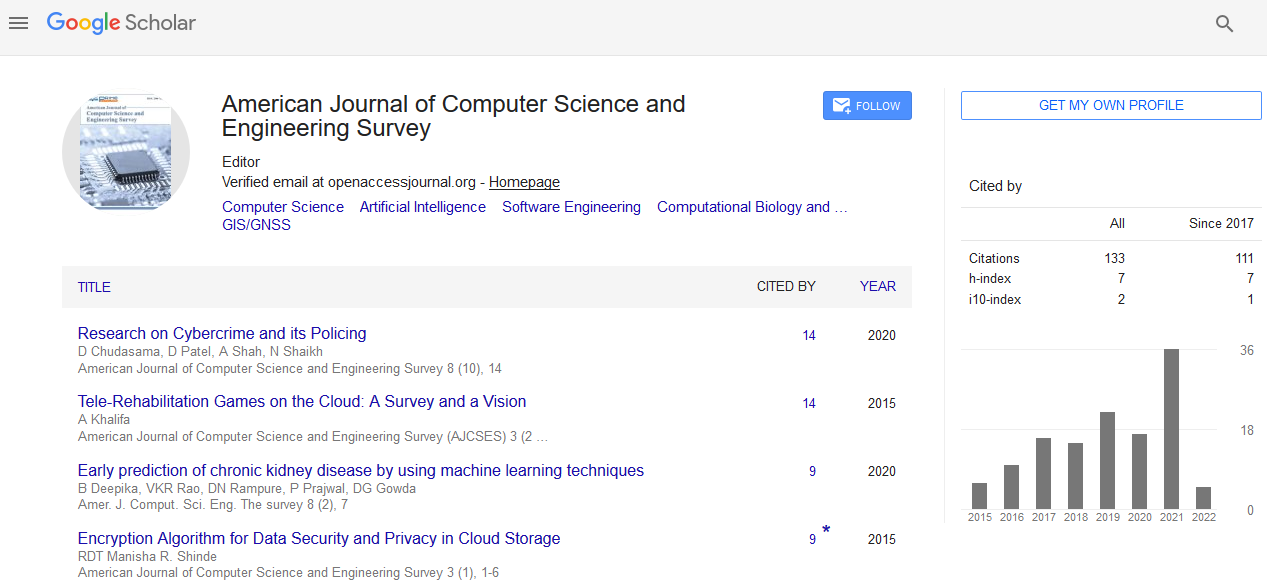Commentary Article - (2022) Volume 10, Issue 3
Reinforcement Learning using Computer Application and Artificial Intelligence
Shangding Gu*
Department of Computer Science, Technical University of Munich, Germany
*Correspondence:
Shangding Gu, Department of Computer Science, Technical University of Munich,
Germany,
Email:
Received: 02-May-2022, Manuscript No. IPACSES-22-13602;
Editor assigned: 04-May-2022, Pre QC No. IPACSES-22-13602(PQ);
Reviewed: 18-May-2022, QC No. IPACSES-22-13602;
Revised: 23-May-2022, Manuscript No. IPACSES-22-13602(R);
Published:
30-May-2022, DOI: 10.36846/2349-7238-10.3.11
Description
Over the past decades Reinforcement Learning adopted in
many fields, e.g. transportation schedule, traffic signal control,
energy management , wireless security , satellite docking, edge
computing , chemical processes, video games], board games
of Go, shogi, chess and arcade game PAC-MAN , finance , autonomous
driving , recommender systems , resource allocation
,communication and networks , smart grids, video compression,
and robotics, etc. However, a challenging problem which
arises in this domain is: how do we guarantee safety when we
apply RL for real-world applications? After all, unacceptable
catastrophes may arise if we fail to take safety into account
during RL applications in real-world scenarios. For example,
it must not hurt human when robots interact with human in
human-machine interaction environments; false or racially discriminating
information should not be recommended for people
in recommender systems; safety has to be ensured when
self-driving cars are carrying out tasks in real-world environments.
More specifically, we introduce several types of safety
definition from different perspectives, which might be useful
for safe RL research. Safety definition the first type of safety
definition: according to the definition of Oxford dictionary, the
phrase “safety” is commonly interpreted to mean “the condition
of being protected from or unlikely to cause danger, risk,
or injury.” The second type of safety definition: the definition
of general “safety” according to wiki 2: the state of being “safe”
is defined as “being protected from harm or other dangers”;
“controlling recognized dangers to attain an acceptable level of
risk” is also referred to as “safety”. The third type of safety definition:
according to Hans et al., humans need to label environmental states as “safe” or “unsafe,” and agents are considered
“safe” if “they never reach unsafe states”. The fifth type of safety
definitions: Moldovan and Abbeel consider an agent “safe”
if “it meets an ergodicity requirement: it can reach each state
it visits from any other state it visits, allowing for reversible errors”.
In this review, based on the above various definitions, we
investigate safe RL methods which are about optimising cost
objectives, avoiding adversary attacks, improving undesirable
situations, reducing risk, and controlling agents to be safe, etc.
Safe reinforcement learning is often modelled as a Constrained
Markov Decision Process (CMDP), in which we need to maximise
the agent reward while making agents satisfy safety constraints.
There is a substantial body of literature that has studied
Constrained Markov Decision Process (CMDP) problems for
both tabular and linear cases. However, deep safe RL for high
dimensional and continuous CMDP optimisation problems is
a relatively new area which has emerged in recent years, and
proximal optimal values generally represent safe states or actions
using neural networks. In this section, we illustrate the
generally deep safe RL problem formulation with respect to the
objective functions of safe RL, and offer an introduction of safe
RL surveys.
Acknowledgement
None.
Conflict of Interest
The author declares there is no conflict of interest in publishing
this article.
Citation: Shangding G. (2022) Reinforcement Learning using Computer Application and Artificial Intelligence. Am J Comp Science Eng Surv. 10:11.
Copyright: © Shangding G. This is an open-access article distributed under the terms of the Creative Commons Attribution License, which permits unrestricted use, distribution, and reproduction in any medium, provided the original author and source are credited.

